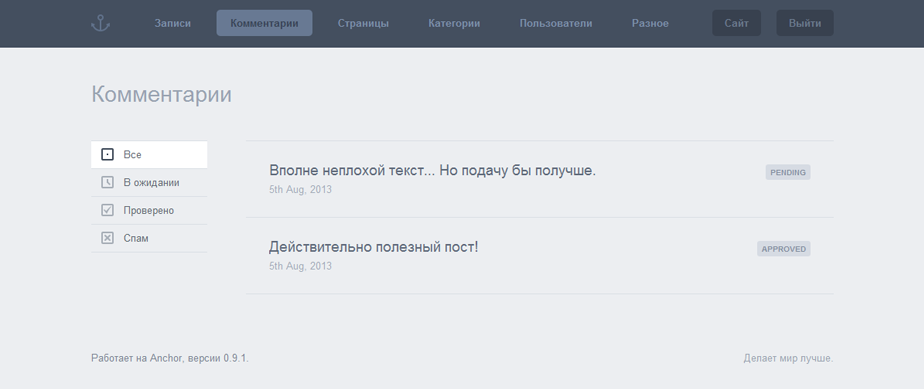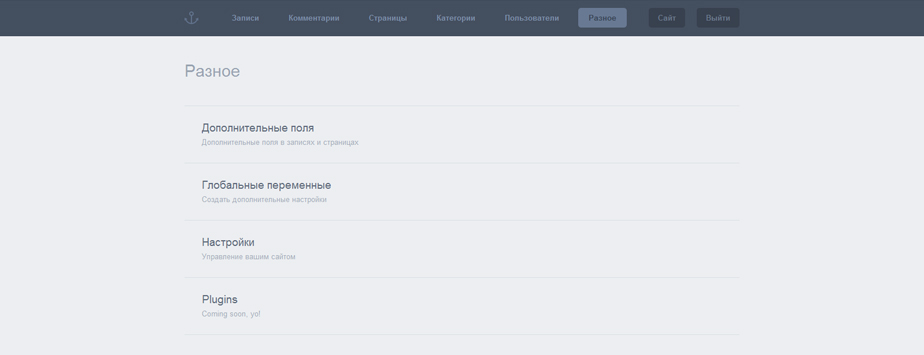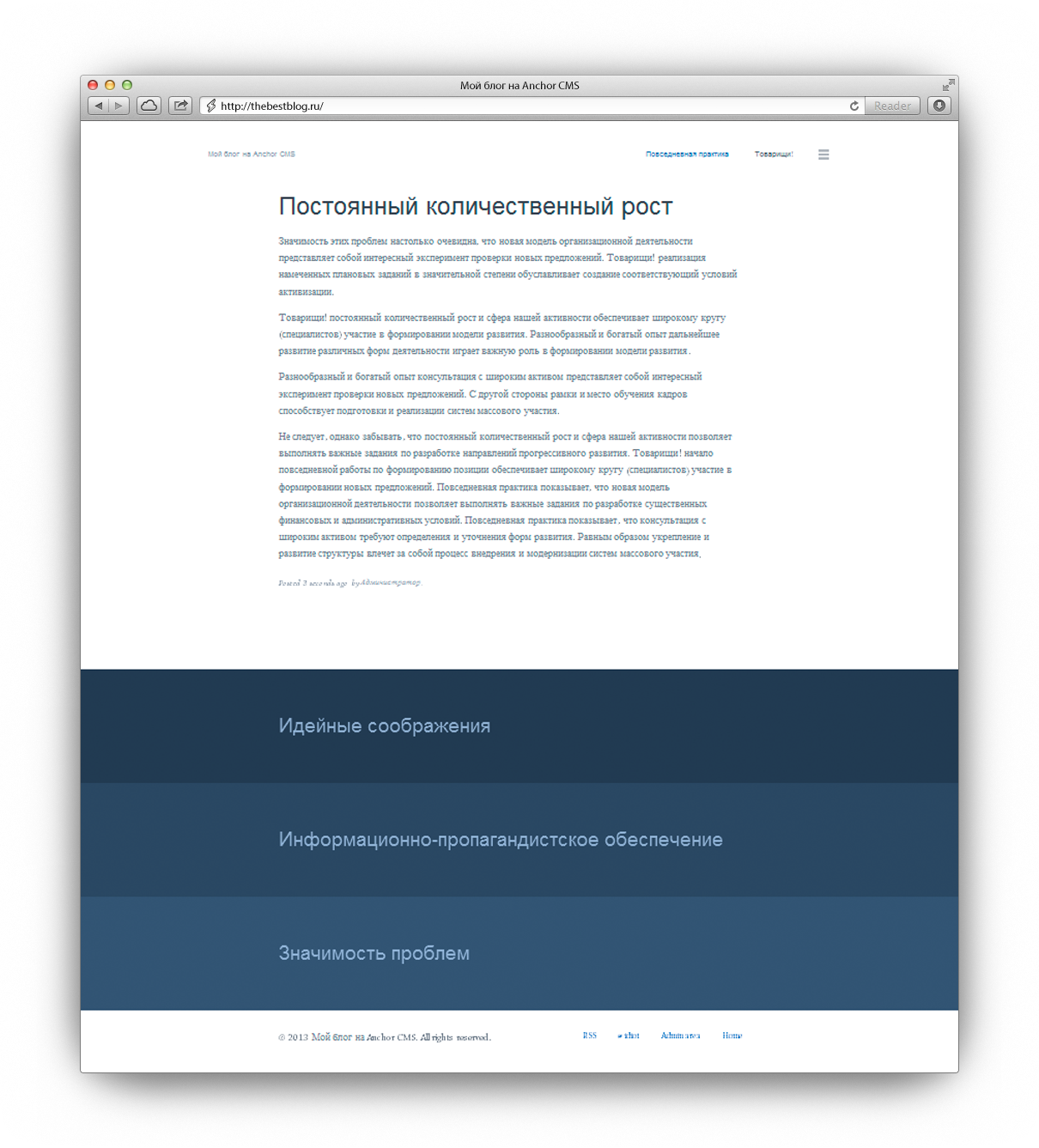Review Anchor CMS - throw anchor into the bay of bloggers

Introduction
I encountered this CMS, not surprisingly, on GitHub . At the request of “CMS” she is on the 3rd place, immediately after Joomla. Anchor developers lure us:
- Free
- Very small weight CMS. Anchor weighs less than a regular JPG image (~ 150kb)
- The simplicity of creating themes. All you need is basic knowledge of HTML / CSS and PHP.
- Incredible ease of management
Let's see and see if this is true, and whether Anchor has any potential.
Filling
Before you start watching the CMS itself, let's talk a little about its insides. For the system to work, you must have PHP version 5.3.6+, and a MySQL 5.2+ database. At the core of CMS is the Nano engine, which supports the MVC architecture (Model-View-Controller), ORM technology, and modern chips.
')
Getting Started: Installation

Work with any CMS begins, of course, with its installation. Installation Anchor CMS is divided into 4 steps. In the first window, we are offered to choose a language (there is still a Russian) and a timezone, in the second - to configure access to the database, in the third - the site name, its description and, if necessary, the location of the site files. In the last window you need to set the administrator name, password and email. Installation is simple and takes no more than 3 minutes.
Admin panel

So the installation is complete. Click on the cherished button and get into the admin area. Here we are met by a super-minimalistic design - I haven’t yet met this in CMS. As you can see, the site is managed using 6 points: records, comments, pages, categories, users and miscellaneous (this is the name of the block with the settings of the site). On the left, two more buttons that allow you to open the site (and it opens in the current window is inconvenient) and exit the admin panel.
In general, the admin panel is nice and creates a feeling of lightweight WordPress. Well, let's go to the overview of the menu items. First in line - Records.
Records
You see the section itself on the screenshot above and there is nothing supernatural there - two columns with a list of categories and entries. The most interesting thing here lies under the button "Write a record."

The process of creating a record to the disgrace is simple - and this is its main problem. You will not find any “advanced” fields - only the title, the text itself, its address, category, and a brief description. Everything. Opportunities for "visual" text formatting are also not enough - you can choose a font (bold or italic) or insert a quote, piece of code or link. However, no one bothers you to use ordinary html-tags - this is a definite plus.
Comments

If, by publishing the material, you have included the possibility of commenting, the user can leave a comment under him. In this section, these same comments can be managed - approve / block and view the sender's data (name, mail and the comment itself). In general, the system is similar to WordPress.
Pages
Everything is similar to the records. The same fields are used for editing, except that the page can be placed in the menu, which is located in the header of the site.
Categories
In this section, you can create new categories and edit existing ones. It's simple.
Users

Here we can edit the data of existing users (including the administrator), as well as create new ones. There are 3 categories of users: administrator, editor and subscriber. Their respective rights are: the admin controls, the editor writes, and the subscriber reads :)
miscellanea

Under the tab is different, as I said, are the usual settings. Here they are divided into 4 categories.
The first category "Additional fields" allows you to add to posts and pages add. fields that can contain plain text, a picture, a file, or an arbitrary html insert. Thanks to these fields, we have more opportunities for the design of the material. And that's good.
The next, no less interesting category is called “Global Variables”. With its help, you can create variables (the values of which will be any text), and then, using a special code, insert them into any part of the site.
In the “Settings” category, you can set the site name, a brief description, set the main page, configure the number of posts per page, auto-post comments, e-mail notification and stop words. Also here you can set a template for the site. Included with the CMS is only one, the easiest template.
The last category is devoted to plugins that promise to add in the near future. Yes, unfortunately, there is currently no complete plugin system, which, I think, would definitely strengthen Anchor’s position as a serious competitor in the blogging world, and when this system is implemented, it can provide developers with an easy way to add additional functionality to your project.
Result
Having dealt with the CMS, I decided to add material and see what we can do. It turned out pretty nice, considering that it took no more than 10 minutes. The result is below.

Conclusion
Anchor CMS is a free, fast and super-simple content management system designed mainly for blogging. For her, it is easy to create your template of almost any complexity. All the necessary functions can be used, as they say, out of the box.
One blogging system does not end there. Using it, flexible functions for editing templates and pages, you can create, for example, a cute portfolio ( such or such ) or a promotional website. It all depends on your capabilities and imagination.
I believe that Anchor is quite capable of finding its niche in the world of blogging CMS. Let such popularity as WordPress it will turn out to be achieved, but it will certainly interest a certain circle of people.
Download Anchor CMS on its official website .
Source: https://habr.com/ru/post/188994/
All Articles